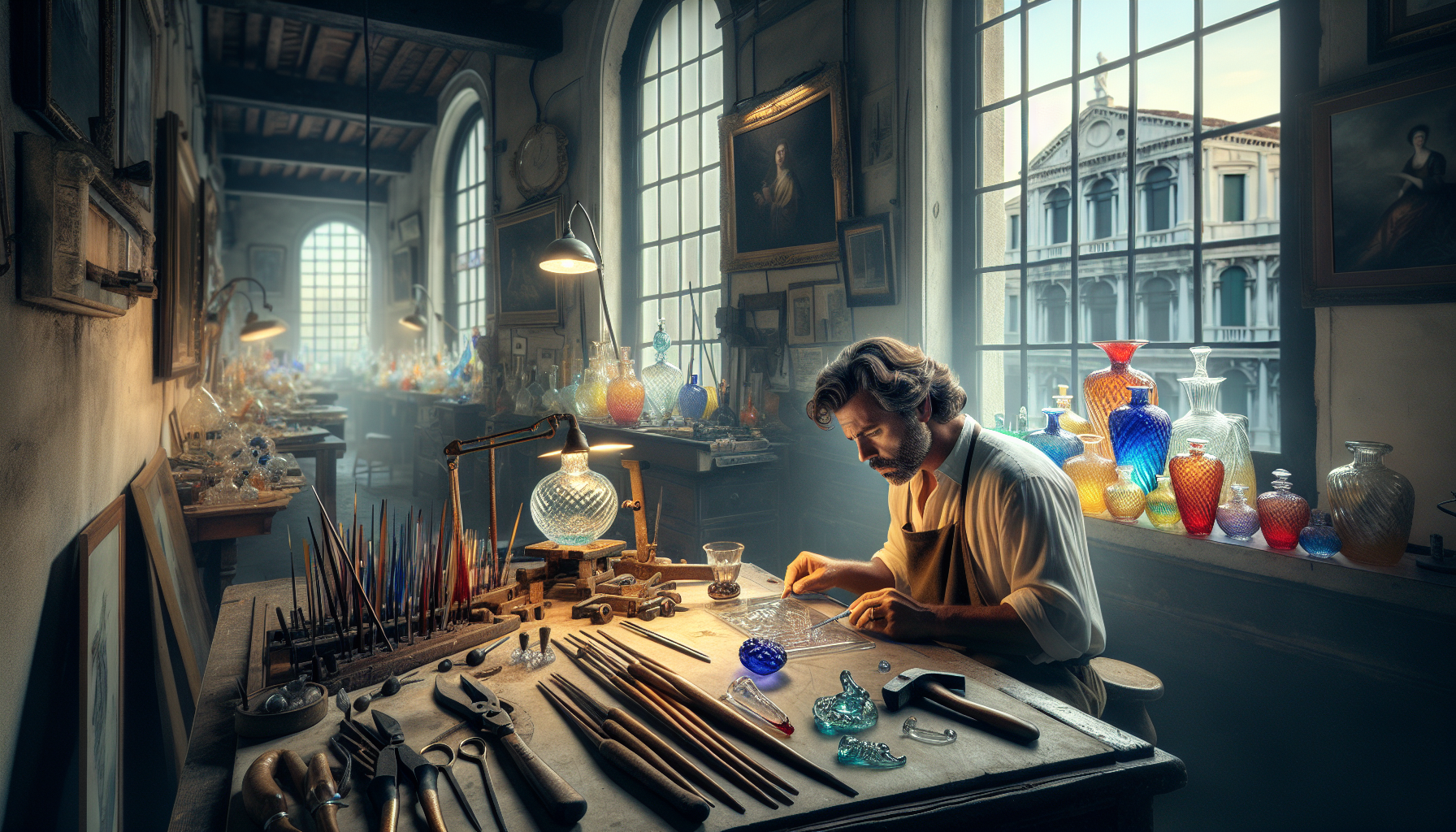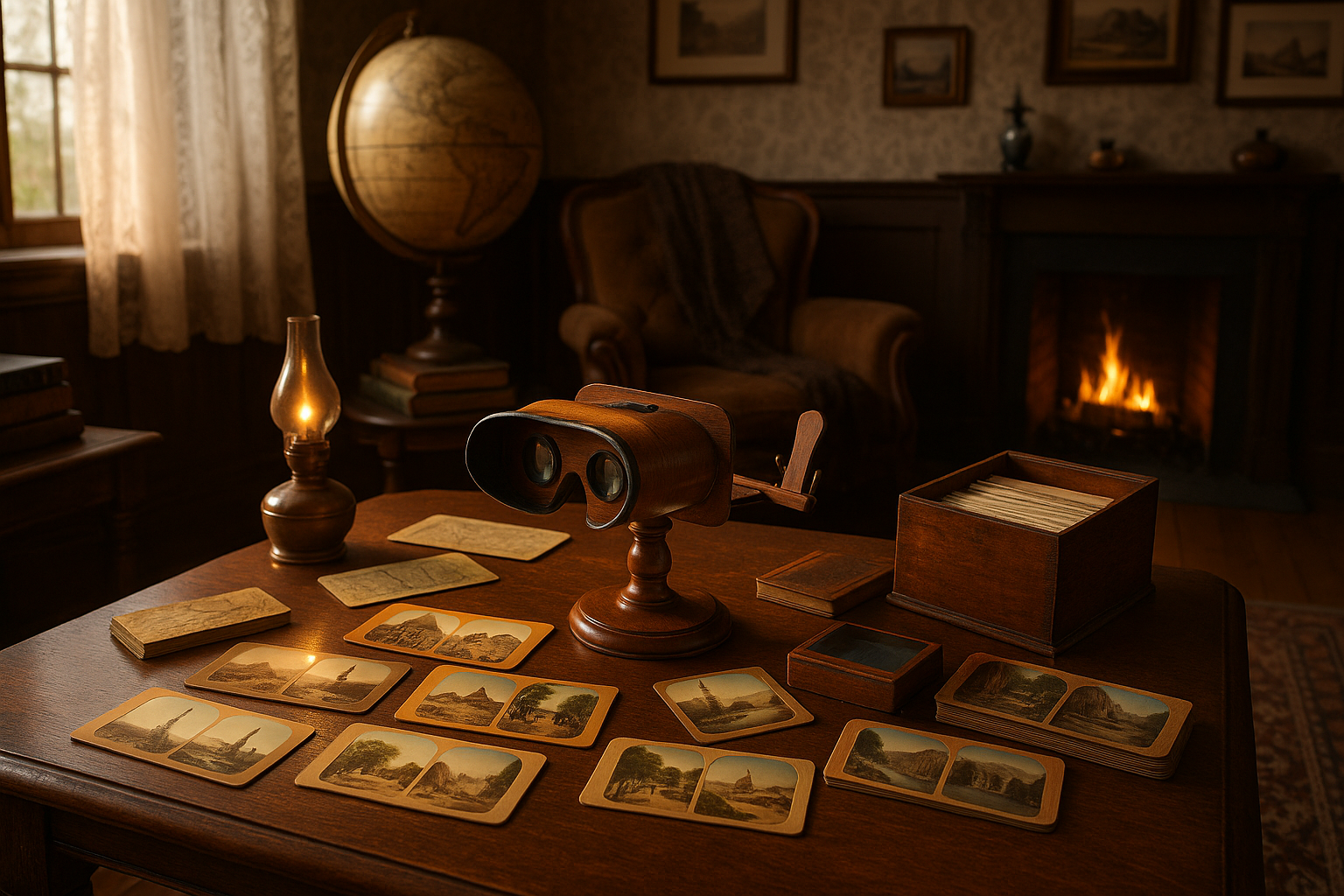In the heart of the Adriatic Sea lies a city that seems to float like a dream upon the water. Venice, with its labyrinthine canals and historic architecture, is a marvel in its own right. But beyond the gondolas and the grandeur of St. Mark’s Basilica, there exists a more delicate, yet equally mesmerizing, aspect of Venetian culture: the exquisite craft of Venetian glassmaking. 🏺 This centuries-old art form, steeped in tradition and shrouded in an aura of mystery, continues to captivate art enthusiasts and collectors around the world. But what is it about Venetian glass that makes it so timeless, and how have the artisans of Murano managed to keep this ancient craft alive in the modern era?
Our journey begins in Murano, a small island situated just a short boat ride away from the main islands of Venice. It is here that the magic happens, where the alchemy of fire and sand transforms into breathtaking works of art. The glassmakers of Murano have perfected their craft over generations, passing down secrets and techniques that date back to the 13th century. This rich heritage is not just a testament to the island’s skilled artisans, but also a reflection of a culture that values beauty, precision, and innovation. As we delve deeper into the history of Venetian glass, we uncover tales of fierce competition, jealously guarded secrets, and artistic rivalry that have shaped the industry into what it is today.
Yet, understanding the allure of Venetian glass requires more than a history lesson. It demands an appreciation for the craftsmanship involved, a recognition of the skill and patience that each piece embodies. From the vibrant colors to the intricate designs, every glass creation tells a story. These are stories of artistry and dedication, of craftsmen who have spent decades honing their skills to produce pieces that are as functional as they are beautiful. Whether it’s a delicate goblet, a stunning chandelier, or an intricate bead, each piece is a testament to the creativity and technical prowess of its maker. In this article, we will explore the different techniques used in Venetian glassmaking, such as filigrana, lattimo, and millefiori, and how these methods contribute to the uniqueness of each piece.
But the story of Venetian glass is not just about the past; it is also about the present and future. In a world increasingly dominated by mass production, the art of handcrafted Venetian glass stands as a beacon of authenticity and individuality. The glassmakers of Murano continue to adapt and innovate, integrating contemporary designs with traditional techniques to appeal to a new generation of collectors and admirers. How do they balance the reverence for tradition with the demands of modernity? What challenges do they face in preserving this ancient craft amidst the pressures of globalization and economic change? These are some of the pressing questions we will address as we examine the current state of the Venetian glass industry.
Finally, our exploration would not be complete without a nod to the profound influence of Venetian glass beyond the borders of Italy. From the palaces of European royalty to the museums of the world, Venetian glass has left an indelible mark on the global stage. It has inspired artists, designers, and architects, and continues to be a source of fascination and admiration. As we conclude our journey, we will reflect on the enduring legacy of Venetian glass and consider its place in the ever-evolving landscape of art and design. So, join us as we unveil the artistry of Venetian glass, and discover the timeless craftsmanship that has captured hearts and imaginations for centuries. 🌟
The Origins of Venetian Glass
Venetian glass, renowned worldwide for its exquisite beauty and craftsmanship, has a rich history that dates back centuries. The origins of this iconic art form can be traced to the island of Murano, where skilled artisans have been perfecting their craft since the late 13th century. The story of Venetian glass is not only one of artistic innovation but also of cultural and economic significance, as it became a symbol of Venice’s wealth and influence during the Renaissance period.
The development of Venetian glass was heavily influenced by the city’s strategic location as a hub for trade between the East and West. This allowed for the exchange of techniques and materials, which artisans skillfully incorporated into their glassmaking processes. During this time, the glassmakers of Murano were granted exclusive privileges by the Venetian Republic, such as tax exemptions and protection of their trade secrets, which helped in fostering an environment of creativity and innovation.
One of the key innovations that emerged from this era was the development of crystal-clear glass known as “cristallo.” This breakthrough was made possible through meticulous refining techniques and the use of high-quality raw materials. The secrets of cristallo, fiercely guarded by Murano glassmakers, set a new standard in glassmaking, making Venetian glass highly sought after across Europe. This desire for Venetian glass not only enriched the local economy but also positioned Venice as a global leader in luxury goods.
The Techniques and Styles of Venetian Glassmaking
The artistry of Venetian glass is characterized by a variety of unique techniques and styles, each contributing to the overall allure and elegance of the finished product. Among the most iconic techniques is the “filigrana,” which involves the incorporation of delicate threads of colored glass into the structure of the piece, creating intricate patterns and designs. This technique requires exceptional skill and precision, as the glass must be handled at high temperatures while maintaining its intricate detail.
Another notable style is the “millefiori,” or “a thousand flowers,” where small, colorful glass rods are fused together to create floral patterns within the glass. This technique adds a vibrant and playful touch to the pieces, making them highly desirable for decorative purposes. The creation of millefiori is a labor-intensive process, requiring careful planning and execution to achieve the desired visual effect. The result is a mesmerizing array of colors and patterns that captivate the eye and spark the imagination.
In addition to these techniques, Venetian glassmakers also excel in creating glass with stunning surface textures and finishes. The “sommerso” technique, for instance, involves layering different colors of glass to produce a submerged effect, adding depth and dimension to the piece. The “lattimo” technique, on the other hand, results in opaque white glass that resembles porcelain. This technique was particularly popular during the Renaissance, as it allowed for the imitation of Chinese porcelain, which was highly prized at the time.
Comparative Table: Venetian Glass Techniques
| Technique | Description | Unique Features |
|---|---|---|
| Filigrana | Incorporation of colored glass threads | Intricate patterns, delicate execution |
| Millefiori | Fusion of small, colorful glass rods | Vibrant colors, floral patterns |
| Sommerso | Layering of glass colors for submerged effect | Depth and dimension |
| Lattimo | Opaque white glass resembling porcelain | Imitation of porcelain, historical significance |
The Impact of Venetian Glass on Art and Culture
The influence of Venetian glass extends far beyond the realm of decorative arts, as it has played a significant role in shaping both artistic and cultural landscapes throughout history. During the Renaissance, Venetian glass was not only a symbol of wealth and status but also a medium through which artists could express their creativity and innovation. The unique qualities of Venetian glass, such as its transparency and ability to be molded into intricate shapes, allowed artists to explore new forms and techniques, pushing the boundaries of traditional art forms.
Venetian glass also had a profound impact on the development of glassmaking in other regions. As European demand for luxury goods grew, glassmakers from other parts of Europe sought to emulate the techniques and styles of their Venetian counterparts. This led to the establishment of glassmaking centers in places such as Bohemia and England, where artisans developed their own distinctive styles while drawing inspiration from Venetian traditions. The exchange of ideas and techniques between these regions contributed to the evolution of glass art, resulting in a rich and diverse tapestry of styles and innovations.
Furthermore, the cultural significance of Venetian glass is evident in its enduring popularity and continued relevance in modern times. Today, contemporary artists and designers draw inspiration from the timeless beauty of Venetian glass, incorporating its techniques and aesthetics into their work. This ongoing legacy ensures that the artistry of Venetian glass continues to captivate and inspire new generations, keeping the traditions and skills of Murano glassmakers alive.
The Legacy and Future of Venetian Glass
The legacy of Venetian glass is one of resilience and adaptation, as the glassmakers of Murano have continuously evolved their craft to meet changing tastes and demands. Despite the challenges posed by modern industrialization and globalization, Venetian glass remains a symbol of artistic excellence and cultural heritage. The commitment to quality and craftsmanship that defines Venetian glassmaking has allowed it to maintain its status as a luxury art form, cherished by collectors and enthusiasts around the world.
In recent years, there has been a renewed interest in traditional crafts and artisanal goods, driven by a growing appreciation for handmade products and sustainable practices. This shift in consumer preferences has provided new opportunities for Venetian glassmakers, who are now able to showcase their skills and creativity to a wider audience. Collaborations with contemporary artists and designers have also breathed new life into the industry, resulting in innovative and exciting interpretations of traditional glassmaking techniques.
Looking to the future, the preservation and promotion of Venetian glass will require a continued commitment to education and training. Efforts to pass down the skills and knowledge of glassmaking to new generations are crucial in ensuring the survival of this ancient art form. Initiatives such as workshops and apprenticeships provide aspiring glassmakers with the opportunity to learn from master artisans, ensuring that the traditions and techniques of Venetian glassmaking are kept alive for years to come.
Experience the Magic of Venetian Glass
To truly appreciate the artistry and craftsmanship of Venetian glass, one must witness the magic of its creation firsthand. Murano, the heart of Venetian glassmaking, offers visitors the opportunity to explore its rich history and observe skilled artisans at work. From guided tours of glass factories to hands-on workshops, there are countless ways to immerse oneself in the world of Venetian glass and gain a deeper understanding of its beauty and significance.
For those unable to visit Murano in person, there are still many ways to experience the wonder of Venetian glass from afar. Explore virtual tours and online galleries showcasing the work of talented glassmakers, or discover the stories behind iconic pieces through documentaries and films. The following video provides an insightful look into the world of Venetian glass, capturing the dedication and passion of the artisans who continue to keep this timeless craft alive:
Watch this insightful video: “The Art of Venetian Glassmaking” by Glass Art Channel.
Whether through a visit to Murano or a virtual exploration, the allure of Venetian glass remains as captivating as ever. By delving into its history, techniques, and cultural impact, one can truly appreciate the artistry and craftsmanship that define this extraordinary art form.
- Discover the history and significance of Venetian glass.
- Learn about the unique techniques and styles used by Murano artisans.
- Explore the cultural impact of Venetian glass on art and society.
- Understand the legacy and future of this timeless craft.

Conclusion
Conclusion: Celebrating the Timeless Craftsmanship of Venetian Glass
In the mesmerizing world of Venetian glass, we have journeyed through the intricate artistry and time-honored craftsmanship that defines this unique art form. Throughout this article, we’ve explored the rich history, the meticulous techniques, and the contemporary significance of Venetian glassmaking. As we conclude, let’s revisit these key aspects, reflect on their importance, and consider how we can appreciate and preserve this remarkable heritage.
Venetian glass, a symbol of elegance and artistry, traces its origins back to the 13th century on the island of Murano, where artisans first began to refine their skills in glassmaking. The historical context of Venetian glass is a tale of innovation and resilience, marked by a commitment to excellence that has transcended generations. These glassmakers were pioneers, combining traditional methods with their creative vision to produce works of art that captivated the world.
The heart of Venetian glass lies in its techniques, which are both complex and fascinating. From the meticulous process of lampworking to the dynamic method of glassblowing, each technique requires not only skill but also a deep understanding of the material. The use of various minerals to add vibrant colors and the precision in shaping each piece are testaments to the artisans’ dedication. It’s this mastery that allows Venetian glass to stand out as a true art form, embodying both beauty and technical prowess.
In today’s world, the significance of Venetian glass extends beyond its aesthetic appeal. It represents a cultural legacy that connects us to a time when craftsmanship was paramount. In a rapidly changing world where technology often overshadows tradition, Venetian glass reminds us of the value of preserving cultural heritage. The artisans of Murano continue to uphold these traditions, ensuring that the knowledge and skills are passed down to future generations.
The importance of supporting and promoting Venetian glass cannot be overstated. As admirers of this craft, we have a role to play in its preservation. By purchasing authentic Venetian glass, visiting Murano, or participating in workshops, we can contribute to the continuation of this art form. Additionally, sharing our appreciation and understanding of Venetian glass with others can help raise awareness and encourage support for these artisans.
In conclusion, Venetian glass is not just an art form; it is a testament to human creativity and resilience. It tells a story of tradition, innovation, and timeless beauty that continues to inspire people around the globe. As we celebrate this remarkable craft, let us encourage others to discover its magic, to appreciate its history, and to support the artisans who keep this legacy alive.
Engage with this enchanting art form—comment on your experiences with Venetian glass, share this article with others who might appreciate its beauty, or apply what you’ve learned by exploring the rich history and artistry of Venetian glassmakers in person or online. Together, we can ensure that the artistry of Venetian glass continues to captivate and inspire for generations to come. 🌟
For further exploration and to support the artisans, you may visit Murano Glass Italy, which offers authentic Venetian glass pieces and insights into the craft’s rich history. Another valuable resource is the Murano Glass Museum, which provides a comprehensive view of the evolution of glassmaking in Murano.
Let us cherish and celebrate the timeless artistry of Venetian glass, a jewel of human creativity and tradition. 🌈
Toni Santos is a visual historian and artisan whose creative lens is captivated by the forgotten marvels of antique optical devices. Through his thoughtful storytelling, Toni revives the instruments that once transformed light into wonder—camera obscuras, magic lanterns, kaleidoscopes, and other ingenious tools that shaped our earliest visual imaginations.
His journey is rooted in a fascination with how humans have long sought to bend, reflect, and reveal the unseen. Whether tracing the mechanical poetry of 19th-century projectors or illustrating the tactile elegance of early lenses, Toni’s work invites us to see vision itself as an evolving art form.
Blending handcrafted design with historical inquiry, Toni brings to life the material soul of these devices—celebrating not just how they functioned, but what they meant. His creations and curated stories illuminate a world where science, illusion, and beauty were intricately linked through glass and brass.
As the curator of Vizovex, Toni shares detailed studies, reconstructed artifacts, and immersive content that help others rediscover the origins of visual technology and the magic of analog perception.
His work is a tribute to:
The craftsmanship behind early visual instruments
The wonder of seeing through the eyes of another century
The intersection of optics, art, and imagination
Whether you’re a collector, a designer, or someone drawn to the lost poetry of vision, Toni welcomes you into a world where light is a storyteller—one prism, one lens, one forgotten invention at a time.





